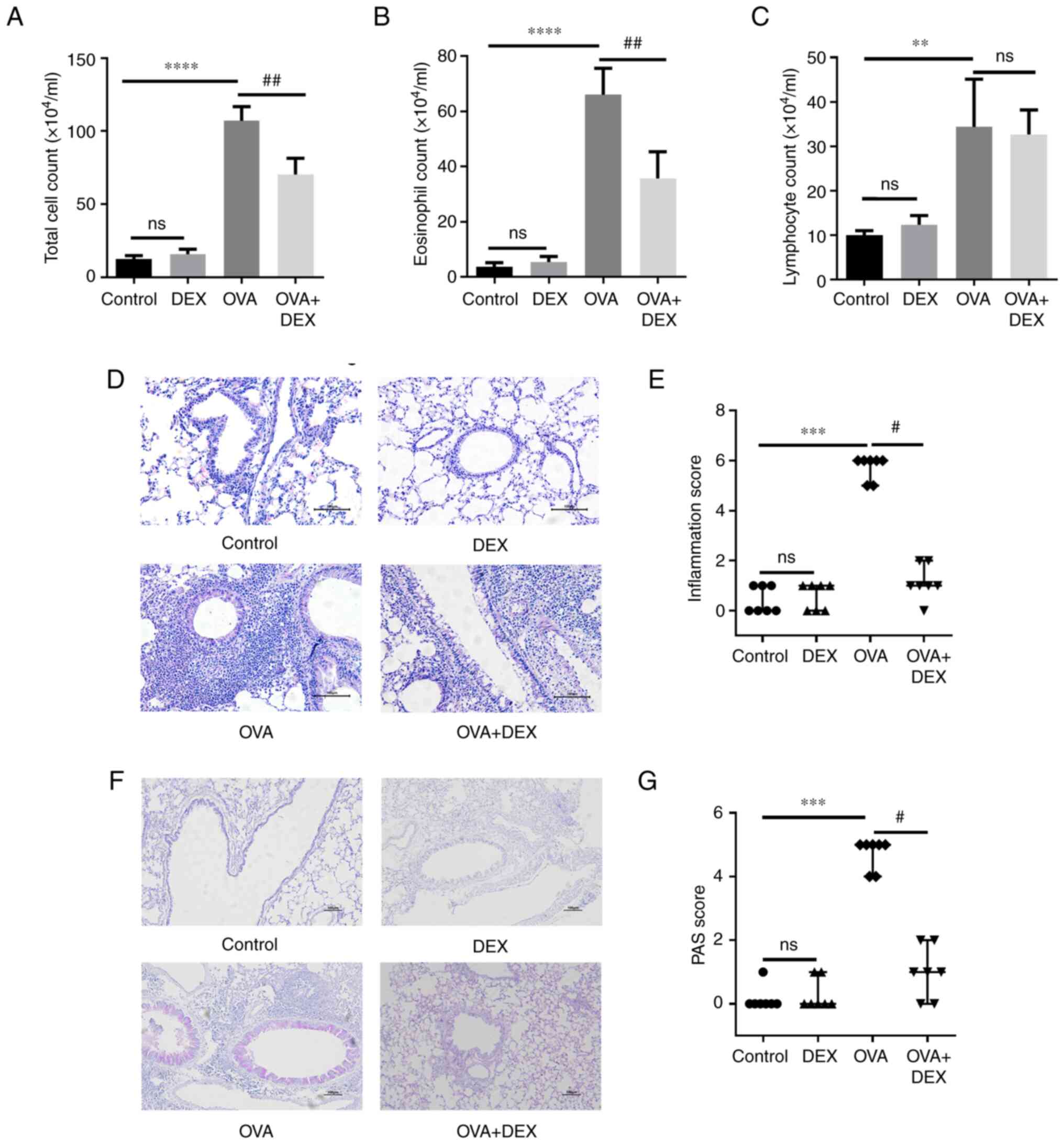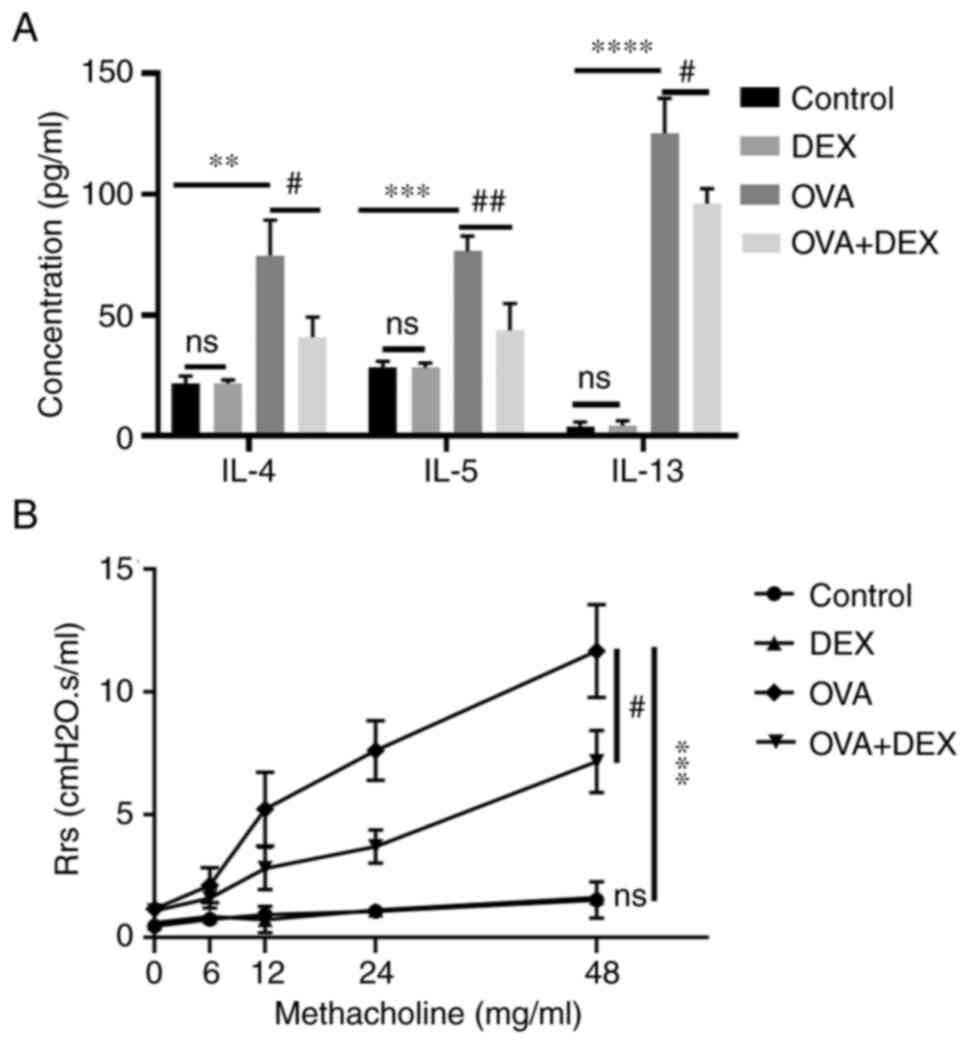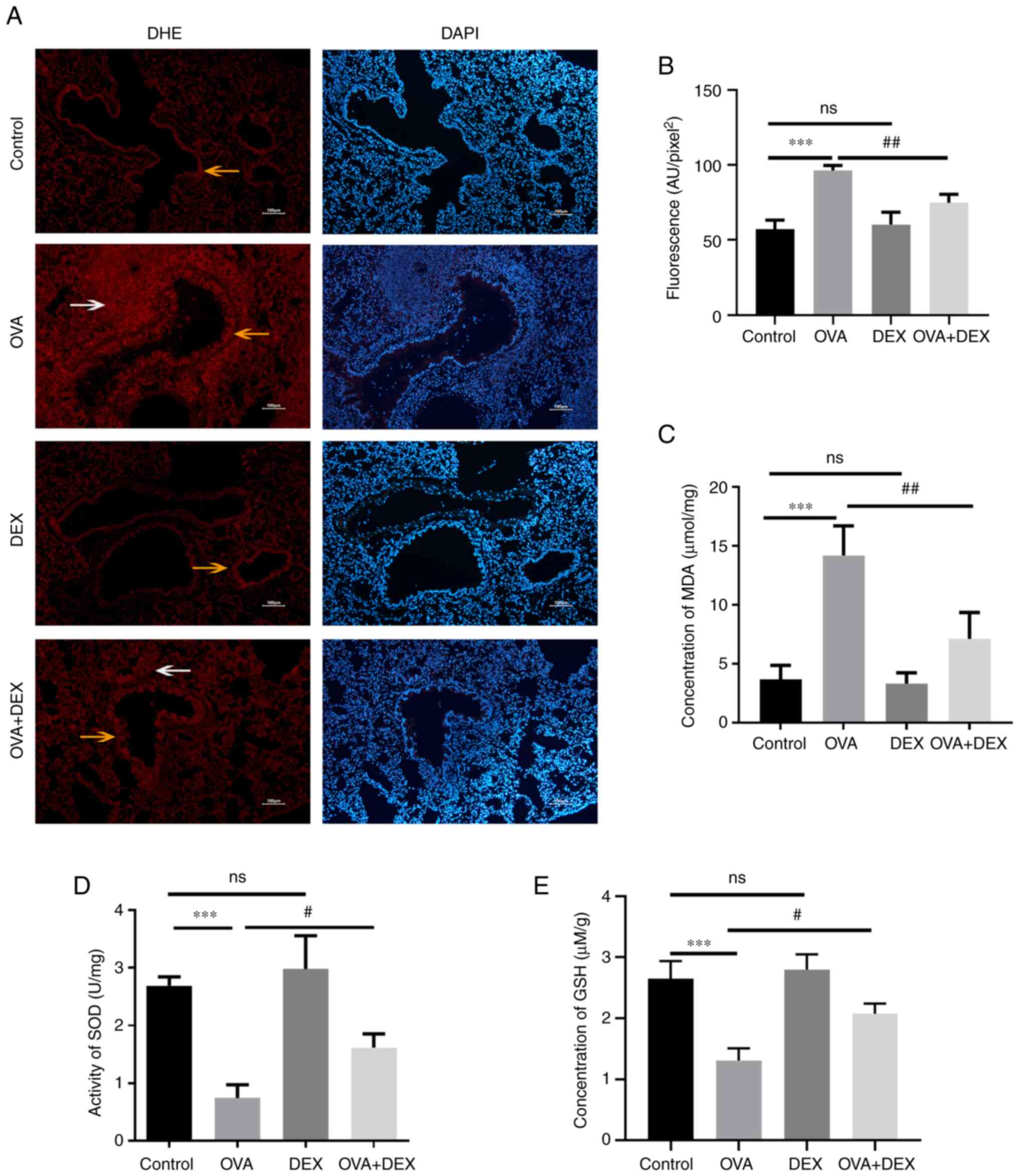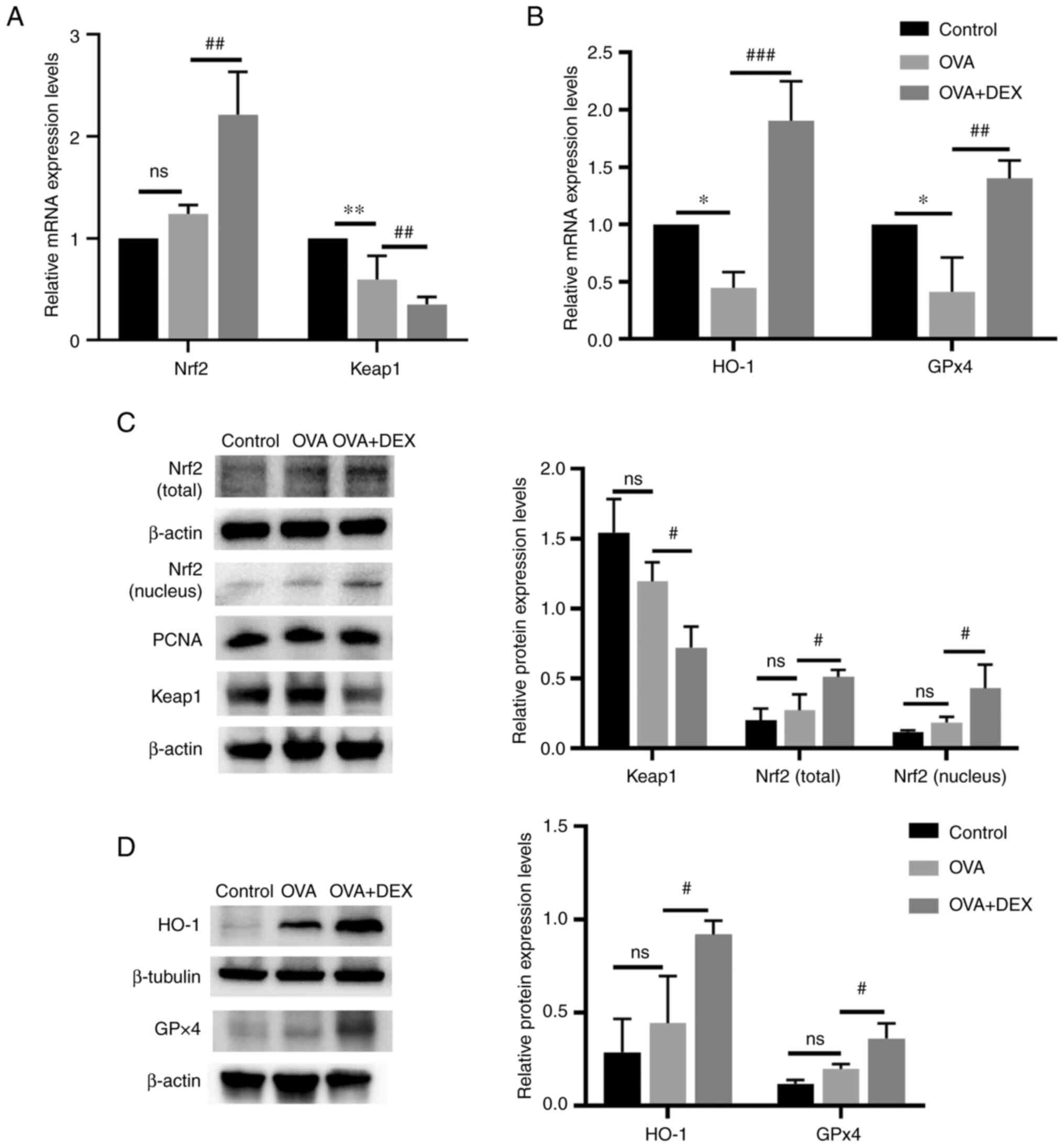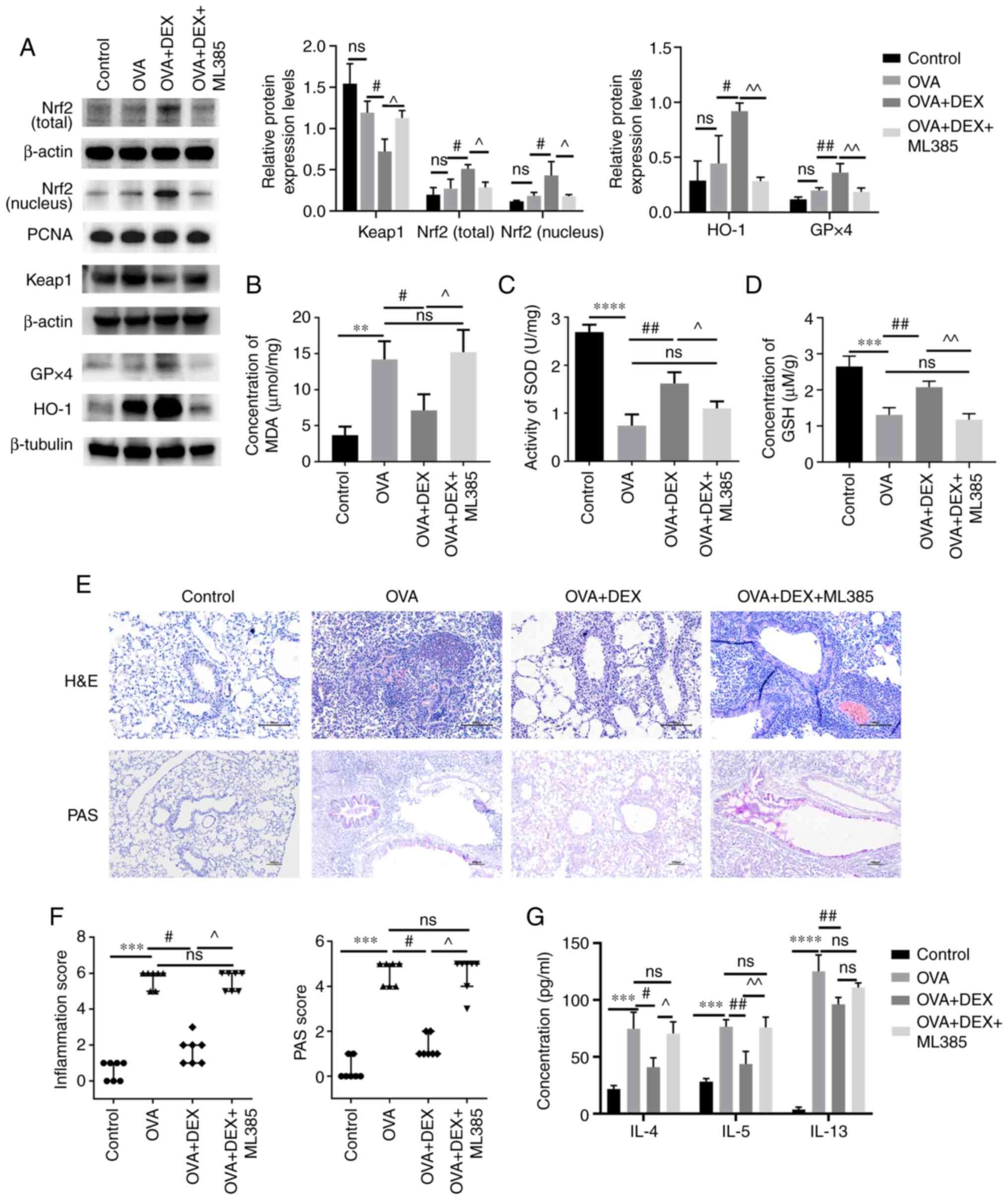|
1
|
Ribeiro A, Aguiar R and Morais-Almeida M:
Biological therapies, asthma and coronavirus disease 2019. Curr
Opin Allergy Clin Immunol. 21:597–601. 2021. View Article : Google Scholar : PubMed/NCBI
|
|
2
|
O'Byrne P, Fabbri LM, Pavord ID, Papi A,
Petruzzelli S and Lange P: Asthma progression and mortality: The
role of inhaled corticosteroids. Eur Respir J. 54:19004912019.
View Article : Google Scholar : PubMed/NCBI
|
|
3
|
Miller RL, Grayson MH and Strothman K:
Advances in asthma: New understandings of asthma's natural history,
risk factors, underlying mechanisms, and clinical management. J
Allergy Clin Immunol. 148:1430–1441. 2021. View Article : Google Scholar : PubMed/NCBI
|
|
4
|
Chipps BE, Murphy KR and Oppenheimer J:
2020 NAEPP guidelines update and GINA 2021-asthma care differences,
overlap, and challenges. J Allergy Clin Immunol Pract. 10((1S)):
S19–S30. 2022. View Article : Google Scholar : PubMed/NCBI
|
|
5
|
Nakagome K and Nagata M: Involvement and
possible role of eosinophils in asthma exacerbation. Front Immunol.
9:22202018. View Article : Google Scholar : PubMed/NCBI
|
|
6
|
Djukanovic R: Airway inflammation in
asthma and its consequences: Implications for treatment in children
and adults. J Allergy Clin Immunol. 109 (6 Suppl):S539–S548. 2002.
View Article : Google Scholar : PubMed/NCBI
|
|
7
|
Pizzino G, Irrera N, Cucinotta M, Pallio
G, Mannino F, Arcoraci V, Squadrito F, Altavilla D and Bitto A:
Oxidative stress: Harms and benefits for human health. Oxid Med
Cell Longev. 2017:84167632017. View Article : Google Scholar : PubMed/NCBI
|
|
8
|
de Groot LES, Sabogal Piñeros YS, Bal SM,
van de Pol MA, Hamann J, Sterk PJ, Kulik W and Lutter R: Do
eosinophils contribute to oxidative stress in mild asthma? Clin Exp
Allergy. 49:929–931. 2019. View Article : Google Scholar : PubMed/NCBI
|
|
9
|
Checa J and Aran JM: Airway redox
homeostasis and inflammation gone awry: From molecular pathogenesis
to emerging therapeutics in respiratory pathology. Int J Mol Sci.
21:93172020. View Article : Google Scholar : PubMed/NCBI
|
|
10
|
Riedl MA and Nel AE: Importance of
oxidative stress in the pathogenesis and treatment of asthma. Curr
Opin Allergy Clin Immunol. 8:49–56. 2008. View Article : Google Scholar : PubMed/NCBI
|
|
11
|
Fatani SH: Biomarkers of oxidative stress
in acute and chronic bronchial asthma. J Asthma. 51:578–584. 2014.
View Article : Google Scholar : PubMed/NCBI
|
|
12
|
Wang P, Geng J, Gao J, Zhao H, Li J, Shi
Y, Yang B, Xiao C, Linghu Y, Sun X, et al: Macrophage achieves
self-protection against oxidative stress-induced ageing through the
Mst-Nrf2 axis. Nat Commun. 10:7552019. View Article : Google Scholar : PubMed/NCBI
|
|
13
|
Dang X, He B, Ning Q, Liu Y, Guo J, Niu G
and Chen M: Alantolactone suppresses inflammation, apoptosis and
oxidative stress in cigarette smoke-induced human bronchial
epithelial cells through activation of Nrf2/HO-1 and inhibition of
the NF-κB pathways. Respir Res. 21:952020. View Article : Google Scholar : PubMed/NCBI
|
|
14
|
Liu J, Xu Y, Yan M, Yu Y and Guo Y:
18β-Glycyrrhetinic acid suppresses allergic airway inflammation
through NF-κB and Nrf2/HO-1 signaling pathways in asthma mice. Sci
Rep. 12:31212022. View Article : Google Scholar : PubMed/NCBI
|
|
15
|
Rangasamy T, Guo J, Mitzner WA, Roman J,
Singh A, Fryer AD, Yamamoto M, Kensler TW, Tuder RM, Georas SN and
Biswal S: Disruption of Nrf2 enhances susceptibility to severe
airway inflammation and asthma in mice. J Exp Med. 202:47–59. 2005.
View Article : Google Scholar : PubMed/NCBI
|
|
16
|
Sussan TE, Gajghate S, Chatterjee S,
Mandke P, McCormick S, Sudini K, Kumar S, Breysse PN, Diette GB,
Sidhaye VK and Biswal S: Nrf2 reduces allergic asthma in mice
through enhanced airway epithelial cytoprotective function. Am J
Physiol Lung Cell Mol Physiol. 309:L27–L36. 2015. View Article : Google Scholar : PubMed/NCBI
|
|
17
|
Gertler R, Brown HC, Mitchell DH and
Silvius EN: Dexmedetomidine: A novel sedative-analgesic agent. Proc
(Bayl Univ Med Cent). 14:13–21. 2001.PubMed/NCBI
|
|
18
|
Bao Y, Zhu Y, He G, Ni H, Liu C, Ma L,
Zhang L and Shi D: Dexmedetomidine attenuates neuroinflammation In
LPS-stimulated BV2 microglia cells through upregulation of miR-340.
Drug Des Devel Ther. 13:3465–3475. 2019. View Article : Google Scholar : PubMed/NCBI
|
|
19
|
Xue BB, Chen BH, Tang YN, Weng CW and Lin
LN: Dexmedetomidine protects against lung injury induced by limb
ischemia-reperfusion via the TLR4/MyD88/NF-κB pathway. Kaohsiung J
Med Sci. 35:672–678. 2019. View Article : Google Scholar : PubMed/NCBI
|
|
20
|
Zhou Z, Chen Q, Wan L, Zheng D, Li Z and
Wu Z: Dexmedetomidine protects hepatic cells against oxygen-glucose
deprivation/reperfusion injury via lncRNA CCAT1. Cell Biol Int.
42:1250–1258. 2018. View Article : Google Scholar : PubMed/NCBI
|
|
21
|
Geng Y, Li R, He SX, Yang HH, Deng QT,
Shao XY, Wu YS, Xu WW and Ma Q: Dexmedetomidine attenuates acute
lung injury induced by heatstroke and improve outcome. Shock.
52:532–539. 2019. View Article : Google Scholar : PubMed/NCBI
|
|
22
|
Feng X, Ma W, Zhu J, Jiao W and Wang Y:
Dexmedetomidine alleviates early brain injury following traumatic
brain injury by inhibiting autophagy and neuroinflammation through
the ROS/Nrf2 signaling pathway. Mol Med Rep. 24:6612021. View Article : Google Scholar : PubMed/NCBI
|
|
23
|
Zhao Y, Kong GY, Pei WM, Zhou B, Zhang QQ
and Pan BB: Dexmedetomidine alleviates hepatic injury via the
inhibition of oxidative stress and activation of the Nrf2/HO-1
signaling pathway. Eur Cytokine Netw. 30:88–97. 2019.PubMed/NCBI
|
|
24
|
Li F, Wang X, Zhang Z, Zhang X and Gao P:
Dexmedetomidine attenuates neuroinflammatory-induced apoptosis
after traumatic brain injury via Nrf2 signaling pathway. Ann Clin
Transl Neurol. 6:1825–1835. 2019. View Article : Google Scholar : PubMed/NCBI
|
|
25
|
Xiao S, Wang Q, Gao H, Zhao X, Zhi J and
Yang D: Dexmedetomidine alleviates airway hyperresponsiveness and
allergic airway inflammation through the TLR4/NF-κB signaling
pathway in mice. Mol Med Rep. 25:742022. View Article : Google Scholar : PubMed/NCBI
|
|
26
|
Van Hoecke L, Job ER, Saelens X and Roose
K: Bronchoalveolar lavage of murine lungs to analyze inflammatory
cell infiltration. J Vis Exp. 4:553982017.PubMed/NCBI
|
|
27
|
Marty GD: Blank-field correction for
achieving a uniform white background in brightfield digital
photomicrographs. Biotechniques. 42:7167187202007. View Article : Google Scholar : PubMed/NCBI
|
|
28
|
Livak KJ and Schmittgen TD: Analysis of
relative gene expression data using real-time quantitative PCR and
the 2(−Delta Delta C(T)) method. Methods. 25:402–408. 2001.
View Article : Google Scholar : PubMed/NCBI
|
|
29
|
Davarinejad H: Quantifications of western
blots with imageJ. http://www.yorku.ca/yisheng/Internal/Protocols/ImageJ.pdf
|
|
30
|
Lambrecht BN, Hammad H and Fahy JV: The
cytokines of asthma. Immunity. 50:975–991. 2019. View Article : Google Scholar : PubMed/NCBI
|
|
31
|
Townley RG and Horiba M: Airway
hyperresponsiveness: A story of mice and men and cytokines. Clin
Rev Allergy Immunol. 24:85–110. 2003. View Article : Google Scholar : PubMed/NCBI
|
|
32
|
Comhair SA and Erzurum SC: Redox control
of asthma: Molecular mechanisms and therapeutic opportunities.
Antioxid Redox Signal. 12:93–124. 2010. View Article : Google Scholar : PubMed/NCBI
|
|
33
|
Nagasaki T, Schuyler AJ, Zhao J, Samovich
SN, Yamada K, Deng Y, Ginebaugh SP, Christenson SA, Woodruff PG,
Fahy JV, et al: 15LO1 dictates glutathione redox changes in
asthmatic airway epithelium to worsen type 2 inflammation. J Clin
Invest. 132:e1516852022. View Article : Google Scholar : PubMed/NCBI
|
|
34
|
Baird L and Yamamoto M: The molecular
mechanisms regulating the KEAP1-NRF2 pathway. Mol Cell Biol.
40:e00099–20. 2020. View Article : Google Scholar : PubMed/NCBI
|
|
35
|
Wu Y, Qiu G, Zhang H, Zhu L, Cheng G, Wang
Y, Li Y and Wu W: Dexmedetomidine alleviates hepatic
ischaemia-reperfusion injury via the PI3K/AKT/Nrf2-NLRP3 pathway. J
Cell Mol Med. 25:9983–9994. 2021. View Article : Google Scholar : PubMed/NCBI
|
|
36
|
Cui J, Zhao H, Wang C, Sun JJ, Lu K and Ma
D: Dexmedetomidine attenuates oxidative stress induced lung
alveolar epithelial cell apoptosis in vitro. Oxid Med Cell Longev.
2015:3583962015. View Article : Google Scholar : PubMed/NCBI
|
|
37
|
Casaro M, Souza VR, Oliveira FA and
Ferreira CM: OVA-induced allergic airway inflammation mouse model.
Methods Mol Biol. 1916:297–301. 2019. View Article : Google Scholar : PubMed/NCBI
|
|
38
|
Bosnjak B, Stelzmueller B, Erb KJ and
Epstein MM: Treatment of allergic asthma: Modulation of Th2 cells
and their responses. Respir Res. 12:1142011. View Article : Google Scholar : PubMed/NCBI
|
|
39
|
King MR, Ismail AS, Davis LS and Karp DR:
Oxidative stress promotes polarization of human T cell
differentiation toward a T helper 2 phenotype. J Immunol.
176:2765–2772. 2006. View Article : Google Scholar : PubMed/NCBI
|
|
40
|
Mishra V, Banga J and Silveyra P:
Oxidative stress and cellular pathways of asthma and inflammation:
Therapeutic strategies and pharmacological targets. Pharmacol Ther.
181:169–182. 2018. View Article : Google Scholar : PubMed/NCBI
|
|
41
|
Wu W, Samoszuk MK, Comhair SA, Thomassen
MJ, Farver CF, Dweik RA, Kavuru MS, Erzurum SC and Hazen SL:
Eosinophils generate brominating oxidants in allergen-induced
asthma. J Clin Invest. 105:1455–1463. 2000. View Article : Google Scholar : PubMed/NCBI
|
|
42
|
Reczek CR and Chandel NS: ROS-dependent
signal transduction. Curr Opin Cell Biol. 33:8–13. 2015. View Article : Google Scholar : PubMed/NCBI
|
|
43
|
Cho YS and Moon HB: The role of oxidative
stress in the pathogenesis of asthma. Allergy Asthma Immunol Res.
2:183–187. 2010. View Article : Google Scholar : PubMed/NCBI
|
|
44
|
Casalino-Matsuda SM, Monzón ME and Forteza
RM: Epidermal growth factor receptor activation by epidermal growth
factor mediates oxidant-induced goblet cell metaplasia in human
airway epithelium. Am J Respir Cell Mol Biol. 34:581–591. 2006.
View Article : Google Scholar : PubMed/NCBI
|
|
45
|
Wiegman CH, Michaeloudes C, Haji G, Narang
P, Clarke CJ, Russell KE, Bao W, Pavlidis S, Barnes PJ, Kanerva J,
et al: Oxidative stress-induced mitochondrial dysfunction drives
inflammation and airway smooth muscle remodeling in patients with
chronic obstructive pulmonary disease. J Allergy Clin Immunol.
136:769–780. 2015. View Article : Google Scholar : PubMed/NCBI
|
|
46
|
Chen Q, Zhou Y, Zhou L, Fu Z, Yang C, Zhao
L, Li S, Chen Y, Wu Y, Ling Z, et al: TRPC6-dependent
Ca2+ signaling mediates airway inflammation in response
to oxidative stress via ERK pathway. Cell Death Dis. 11:1702020.
View Article : Google Scholar : PubMed/NCBI
|
|
47
|
Park CS, Kim TB, Lee KY, Moon KA, Bae YJ,
Jang MK, Cho YS and Moon HB: Increased oxidative stress in the
airway and development of allergic inflammation in a mouse model of
asthma. Ann Allergy Asthma Immunol. 103:238–247. 2009. View Article : Google Scholar : PubMed/NCBI
|
|
48
|
Comhair SA, Ricci KS, Arroliga M, Lara AR,
Dweik RA, Song W, Hazen SL, Bleecker ER, Busse WW, Chung KF, et al:
Correlation of systemic superoxide dismutase deficiency to airflow
obstruction in asthma. Am J Respir Crit Care Med. 172:306–313.
2005. View Article : Google Scholar : PubMed/NCBI
|
|
49
|
Sharma A, Bansal S and Nagpal RK: Lipid
peroxidation in bronchial asthma. Indian J Pediatr. 70:715–717.
2003. View Article : Google Scholar : PubMed/NCBI
|
|
50
|
Fitzpatrick AM, Jones DP and Brown LA:
Glutathione redox control of asthma: From molecular mechanisms to
therapeutic opportunities. Antioxid Redox Signal. 17:375–408. 2012.
View Article : Google Scholar : PubMed/NCBI
|
|
51
|
Comhair SA, Bhathena PR, Dweik RA, Kavuru
M and Erzurum SC: Rapid loss of superoxide dismutase activity
during antigen-induced asthmatic response. Lancet. 355:6242000.
View Article : Google Scholar : PubMed/NCBI
|
|
52
|
Liu Q, Gao Y and Ci X: Role of Nrf2 and
its activators in respiratory diseases. Oxid Med Cell Longev.
2019:70905342019.PubMed/NCBI
|
|
53
|
Park YH, Park HP, Kim E, Lee H, Hwang JW,
Jeon YT and Lim YJ: The antioxidant effect of preischemic
dexmedetomidine in a rat model: Increased expression of Nrf2/HO-1
via the PKC pathway. Braz J Anesthesiol. S0104-0014(21)00331-6.
2021.(Epub ahead of print).
|
|
54
|
Kopacz A, Kloska D, Forman HJ, Jozkowicz A
and Grochot-Przeczek A: Beyond repression of Nrf2: An update on
Keap1. Free Radic Biol Med. 157:63–74. 2020. View Article : Google Scholar : PubMed/NCBI
|
|
55
|
Kansanen E, Kuosmanen SM, Leinonen H and
Levonen AL: The Keap1-Nrf2 pathway: Mechanisms of activation and
dysregulation in cancer. Redox Biol. 1:45–49. 2013. View Article : Google Scholar : PubMed/NCBI
|
|
56
|
Wu W, Du Z and Wu L: Dexmedetomidine
attenuates hypoxia-induced cardiomyocyte injury by promoting
telomere/telomerase activity: Possible involvement of ERK1/2-Nrf2
signaling pathway. Cell Biol Int. 46:1036–1046. 2022. View Article : Google Scholar : PubMed/NCBI
|
|
57
|
Sun Z, Huang Z and Zhang DD:
Phosphorylation of Nrf2 at multiple sites by MAP kinases has a
limited contribution in modulating the Nrf2-dependent antioxidant
response. PLoS One. 4:e65882009. View Article : Google Scholar : PubMed/NCBI
|
|
58
|
Cheng D, Wu R, Guo Y and Kong AN:
Regulation of Keap1-Nrf2 signaling: The role of epigenetics. Curr
Opin Toxicol. 1:134–138. 2016. View Article : Google Scholar : PubMed/NCBI
|
|
59
|
Lee OH, Jain AK, Papusha V and Jaiswal AK:
An auto-regulatory loop between stress sensors INrf2 and Nrf2
controls their cellular abundance. J Biol Chem. 282:36412–36420.
2007. View Article : Google Scholar : PubMed/NCBI
|
|
60
|
Cullinan SB, Gordan JD, Jin J, Harper JW
and Diehl JA: The Keap1-BTB protein is an adaptor that bridges Nrf2
to a Cul3-based E3 ligase: Oxidative stress sensing by a Cul3-Keap1
ligase. Mol Cell Biol. 24:8477–8486. 2004. View Article : Google Scholar : PubMed/NCBI
|
|
61
|
Kopacz A, Klóska D, Proniewski B, Cysewski
D, Personnic N, Piechota-Polańczyk A, Kaczara P, Zakrzewska A,
Forman HJ, Dulak J, et al: Keap1 controls protein S-nitrosation and
apoptosis-senescence switch in endothelial cells. Redox Biol.
28:1013042020. View Article : Google Scholar : PubMed/NCBI
|
|
62
|
Taguchi K, Fujikawa N, Komatsu M, Ishii T,
Unno M, Akaike T, Motohashi H and Yamamoto M: Keap1 degradation by
autophagy for the maintenance of redox homeostasis. Proc Natl Acad
Sci USA. 109:13561–13566. 2012. View Article : Google Scholar : PubMed/NCBI
|
|
63
|
Liu Y, Liu W, Wang XQ, Wan ZH, Liu YQ and
Zhang MJ: Dexmedetomidine relieves neuropathic pain in rats with
chronic constriction injury via the Keap1-Nrf2 pathway. Front Cell
Dev Biol. 9:7149962021. View Article : Google Scholar : PubMed/NCBI
|
|
64
|
Rockwell CE, Jin Y, Boss AP, Kaiser LM and
Awali S: The complicated role of nuclear factor erythroid-derived
2-like 2 in allergy and asthma. Drug Metab Dispos. 50:500–507.
2022. View Article : Google Scholar : PubMed/NCBI
|
|
65
|
Ammar M, Bahloul N, Amri O, Omri R, Ghozzi
H, Kammoun S, Zeghal K and Ben Mahmoud L: Oxidative stress in
patients with asthma and its relation to uncontrolled asthma. J
Clin Lab Anal. 36:e243452022. View Article : Google Scholar : PubMed/NCBI
|















